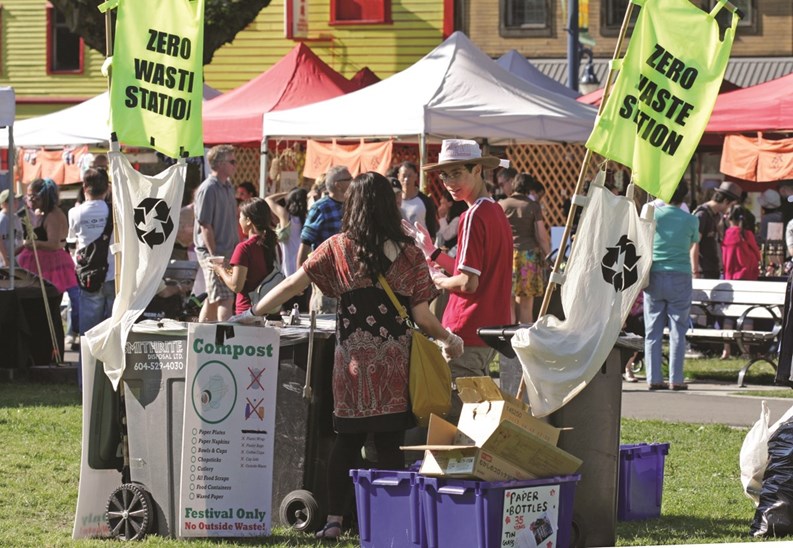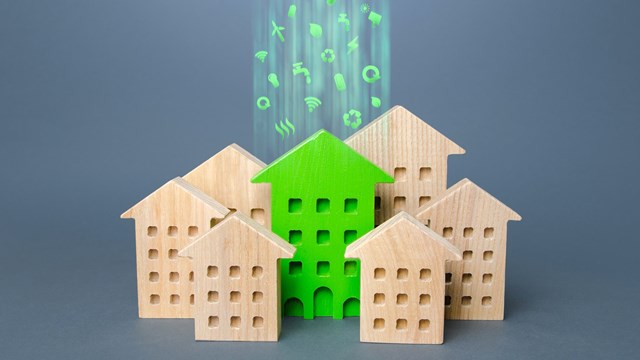These days, as the summers get hotter, the storms get bigger and climate change is finding its way into more headlines than ever before, more attention is being paid to the environment and how the average citizen can do his or her part to support it. For years, New York City has been a leader in energy conservation, waste reduction and the creation of green policies designed to prepare its buildings and its residents for life in an uncertain environmental future.
As a result, boards and managers finding themselves introducing new rules, regulations and technologies into co-ops and condos to improve comfort for residents and work in tandem with citywide efforts to be better stewards of our resources and climate. And it is a trend that seems to be growing.
People Want to Know
“We regularly have board members reach out to their management team about greening their property,” says Doug Weinstein, executive director of operations and vice president of New York-based Project Management Group (PMG) and AKAM Associates. “And PMG consistently receives inquiries for more information on how to be energy efficient and continue to rise. You also have many new buildings being constructed with sustainability and greening practices in mind from their inception.”
Cecil Scheib, PE, CEM, LEED AP, GPRO, chief program officer of the Urban Green Council in New York, has seen first-hand the results of buildings focusing on energy conservation and green policies. “It happened in my building,” he says, citing a conversion to LED lighting. Throughout the city, “We’re seeing a trend,” he says, especially involving management companies making suggestions and providing guidance on renovations and upgrades.
Shades of Green
Aaron Mehta, the director of energy information for FS Energy, a subsidiary of the nationwide residential property management firm FirstService Residential, says getting boards and residents involved in greening is through information and education. “The most effective way is to inform our board members and residents so that they actually have the tools and the resources to make the decisions,” says Mehta.
A novel way of doing this is issuing energy report cards, he says. The New York division of FirstService Residential has for the last five years issued the report cards to the more than 400 multifamily properties in its portfolio. “The goal is to inspire co-op and condo board members to implement efficiency measures that can collectively save nearly $18 million in energy costs annually,” states Dan Wurtzel, president of FirstService Residential New York.
“We have a social responsibility to protect the environment by guiding our clients on the road to efficiency and our sizable portfolio presents us with a significant opportunity to effect real change,” Wurtzel says. “Providing report cards to our clients enables them to make informed decisions about which strategies to initiate within their buildings to become more energy-efficient while also realizing cost savings.”
Mehta explains that the report cards rate performance on a 0-10 scale and buildings are given what’s called a BERG benchmarking score, which stands for Building Energy Rating Guide. The score gauges a building’s energy efficiency standing compared to similar properties. The report cards, he says, are offered as a complimentary service to FSR buildings. Boards can use the scores to compare their buildings to their peers and their neighbors, Mehta says. For buildings that are ranked low, the report shows what the major drivers of energy are in their building. And from there they know what are the areas that they need to improve and can start taking action to improve the energy efficiency levels in their buildings.
According to FS Energy, solutions range from no- and low-cost initiatives including lighting upgrades, electric submetering and installation of building management systems to larger projects such as oil-to-gas conversions, heating and cooling system upgrades, and installation of co-generation units.
FS Energy offers a wide range of services to client buildings, he says. One such service is an energy advisory service. “We have an energy engineer on staff that will go visit the building and conduct a baseline ASHRAE Level 1 energy audit, and from this energy audit, the building will know what retrofit measures can be taken, how much they’ll cost, and what the potential energy reduction and cost reduction will be.”
The free service is being rolled out in FSR buildings in New York, Florida and Illinois and soon will be available nationwide, according to Mehta. Another service is that of energy aggregation, where all of the electricity and natural gas usage is combined into a simple request for proposal (RFP) enabling the buildings to purchase their energy supply in bulk.
Encouraging Change
Making major changes in energy consumption or green lifestyles take the support of all residents to be successful.
“In my experience, the important thing is showing people the value of what they can do by going green,” says Scheib. “Each person is motivated by different things. One may say they want to see a spreadsheet of savings, while another may want to hear about how greening may mean less maintenance.”
One approach with almost universal appeal is sharing how changes will affect the everyday lives of people in the building. If, for example, a board is going to replace the boiler controls, Scheib says he would inform residents about how their units will be less drafty and more comfortable since they won't have to open windows to in the winter to ease overheating, and how the upgrade will pay for itself in energy savings.
George Crawford, principal of Green Partners LLC in New York City, also encourages education on the economic benefits of energy conservation. “Any resident, if you tell them ‘I’m going to save you some money,’ they’ll be happy,” he says. “It is possible to go green and save money and that’s the most practical way to approach it.”
Weinstein agrees, adding that once residents understand the improvement greening can make, “they are more receptive to the idea.”
A Team Effort
Working in tandem with management can assist in the transition. “We work with our boards to make it as easy as possible for residents to practice green techniques,” says Weinstein. “Whether that means setting up collection sites that are easily accessible, or training building staff on how to properly handle new greening techniques, we realize the best way to get residents involved is by making it so easy that it becomes second nature to them.”
Green committees also can be helpful in convincing their neighbors and fellow residents of the benefits of a program or technology. For example, “Low-flow toilets can have a fantastic payback that can be measured in months,” says Scheib. They can be a difficult sell, though. “If you have a committee and the committee members can say, ‘We tested five different toilets and everyone agrees this is the best,’ there’s much more trust.” People will listen if they feel that a friend or someone else who is just as invested as they are in the success of the building community has given the proposed change his or her stamp of approval.
Mehta and Weinstein agree. “Green committees definitely help,” Weinstein says, even if it’s only to do smaller initiatives like recycling or composting. “When residents are involved firsthand, then techniques have a tendency to catch on quicker and have larger participation rates. Residents love to say, ‘I helped my building go green.’ They want to know they were personally responsible for reducing their building’s and their own carbon footprint.”
“Forming a green committee whether it’s a group of the actual board of directors or a green committee consisting of tenants” explains Mehta, “they can kick off a program and get engagement from the whole building, whether it be a recycling initiative or composting or helping to implement a major energy retrofit project.”
Making Good Choices
A number of different technologies and initiatives are taking center stage these days. Many of these “revolve around energy consumption—either electric or fuel for heating,” says Crawford.
When it comes time to make a decision about what kind of upgrades or changes will be most impactful for your building and residents, it can help to meet with a consultant who knows what's available, and what's practical for your particular community. Scheib suggests consulting with organizations like the New York State Energy Research and Development Authority (NYSERDA) and the major utility providers in your area, adding that another good resource is New York City Clean Heat.
Initiatives limiting consumption will be key to the city reaching its goal of reducing energy consumption by 80 percent by 2050, says Crawford. “That’s going to be a difficult goal to reach but certainly if as many buildings as possible go to LED lighting or a lot of controls are put on heating systems which give you good comfort levels but save money as well,” that will help.
According to Weinstein, “We continue to see a rise in the implementation of solar panels, green roofs and living walls in building lobbies. I wish it were possible for every property in New York to add solar panels or a green roof, but these initiatives depend on numerous variables, and not every building can be a candidate.”
Seeing the Light
In addition, “The current biggest greening initiative we see is the switch to LED and bi-level lighting,” says Weinstein. “Gas conversions, which are considered a greening technique due to the reduction of the building’s carbon footprint, are a close second. The initial investment for some of these can be high, but the long-term benefits outweigh that initial expense.”
Mehta agrees. “By far, the biggest—the highest ROI retrofit that buildings can do today is replacing their lighting to LED. There’s two factors that come into play—one, the actual costs of LED lighting compared to alternatives—have drastically come down in the past several years, and the second is there are very, very large incentives from Con Ed and NYSERDA to make these lighting improvements.”
Another suggestion he has is to get as short a payback as possible. FS Energy’s procurement and aggregation services are open to the general building population.
Improving heating and cooling also can have a very powerful impact on quality of life, energy conservation and a reduction in costs for buildings. “For heating, you can put in sophisticated controls based on interior temperatures of the building,” says Crawford. “You’re heating what you need to heat and not any more. You can zone the building, like a home. So if the building is warmed by solar heat, you let the sun do its job and not double. You don’t want to heat areas twice. That’s like double dipping.”
This zone approach can alleviate the all-too-common occurrence of residents in one section of a building getting too much heat and having to open windows in the dead of winter while residents in other areas are piling on the sweaters and wiping frost from their windows. Helping residents understand ahead of time how green approaches can make life better and more comfortable is of paramount importance in getting buy-in from the whole building community.
Con Ed also earns high marks from Scheib as well as Crawford to help determine effective approaches to conservation and new technology. They also offer valuable incentives that can help building’s finance and reduce costs in the long run. Says Crawford, “There have been projects where, with the combination of Con Ed incentives and savings from energy reductions, the whole retrofit was paid for in six months. The incentives are such that there is a very quick payback.”
Planning for Change
Planning for green modifications well ahead of time gives residents time to better understand the changes and become invested in the projected results. It also can save money. “You have to plan ahead,” says Scheib. “Doing an engineering plan for a rooftop solar installation might take a while. But you could include it in a feasibility study and plan for it.”
That also allows for projects to be piggybacked on one another. “For infrastructure, for example, the time to do rooftop solar is when the roof needs replacing,” says Scheib. “It’s much easier to add the expense for an energy project into an existing project than doing it separately and off-cycle.”
“The most important thing to start with is to understand where you are, to consistently and periodically benchmark your performance so you can see how usage and costs are changing over time,” says Mehta. “Once you know how much energy you’re using and how much you’re spending and you’ve been tracking it for a number of years, you’re able to identify where you may have opportunities. And after you’ve made retrofits to improve, the benchmarking will allow you to see how much of an impact that specific measure has had. To collect and analyze the energy usage and cost information from your building, you can evaluate the impact of your decisions as well as form future decisions.”
Concern for the environment is a trend that appears to be growing and one that will no doubt pay off for residents with cleaner, more efficient and more comfortable homes. It also may strengthen the bottom lines for co-ops and condos, helping significantly reduce energy costs. Perhaps most importantly, the more buildings that make these transitions, the greater the impact on the environment and the better off we all will be in the decades to come.
Liz Lent is a freelance writer and a frequent contributor to The Cooperator. Managing Editor Debra A. Estock contributed to this article.










Comments
Leave a Comment